Best Native Plants for Phoenix
BY AMANDA SHIFFLER | MARCH 27TH, 2023 | ARIZONA, LAWN CARE, PHOENIXWhen dealing with the challenging climate of the Southwest desert, the key to having a beautiful lawn and garden is working with plants naturally adapted to the hot, arid environment. You can’t expect lily of the valley, which needs moist soil, mild temperatures, and average humidity, to thrive in a dry, sun-baked climate.
Thankfully, there are excellent alternatives, ranging from cacti to shrubs and flowering perennials. We’ve compiled a list of some of the best native plants for your Phoenix landscape.
In this article:
- Understanding Native Plants
- Advantages of Choosing Natives
- 13 Native Plants for Phoenix
- Choosing Native Plants for Your Yard
- Local Native Plant Retailers
What are Native Plants?
The National Wildlife Federation describes a native plant as occurring “naturally in a particular region, ecosystem, or habitat without human introduction.” Simply put, it means a plant has been living in an area for as long as one can remember and wasn’t brought in from a different place. That being the case, you can be assured these species will grow successfully when planted in your yard at home.
Advantages of Native Plants
Since these desert plants grow naturally in the Sonoran Desert region, they have many advantages.
- They are naturally drought-tolerant, or use little water.
- They often thrive in poor soils with little need for supplemental fertilizer.
- They attract native wildlife, including butterflies, bees, and hummingbirds.
- They help maintain the local ecosystem’s balance.
Native Plants for Your Phoenix Yard and Landscaping
Desert Fairy Duster (Calliandra eriophylla)
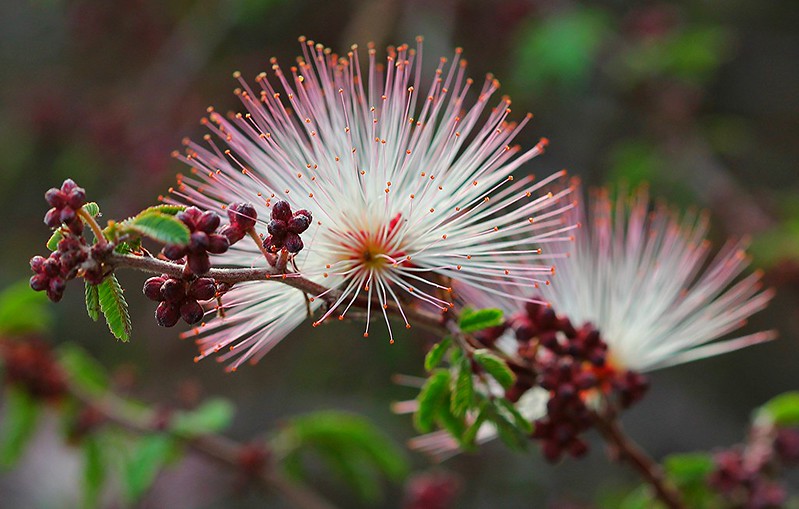
Commonly called false mesquite, the desert fairy duster has delicate, deep green tiny leaflets and vibrant red flowers resembling puffballs. It will keep its leaves year-round as an evergreen, but it may thin slightly during Phoenix’s rare “cold spells.” In most years, you’ll be rewarded with blooms the majority of the year that draw in hummingbirds, finches, and wrens.
Desert fairy duster thrives in areas where you may have struggled to grow anything. Especially those scorching hot spots in full sun right in front of a west-facing wall. There isn’t a spot in the desert landscape that the desert fairy duster considers too hot to grow in – just make sure you give it a little water when it’s overly hot and dry.
Growth Habit: Small evergreen shrub
Mature Height: 3 to 5 feet
Mature Width: 3 to 5 feet
Sunlight Needs: Full sun
Soil Preferences: Well-drained
Water Requirements: Only during extended dry periods
Disease or Insect Problems: No serious problems
Tufted Evening Primrose (Oenothera caespitosa)
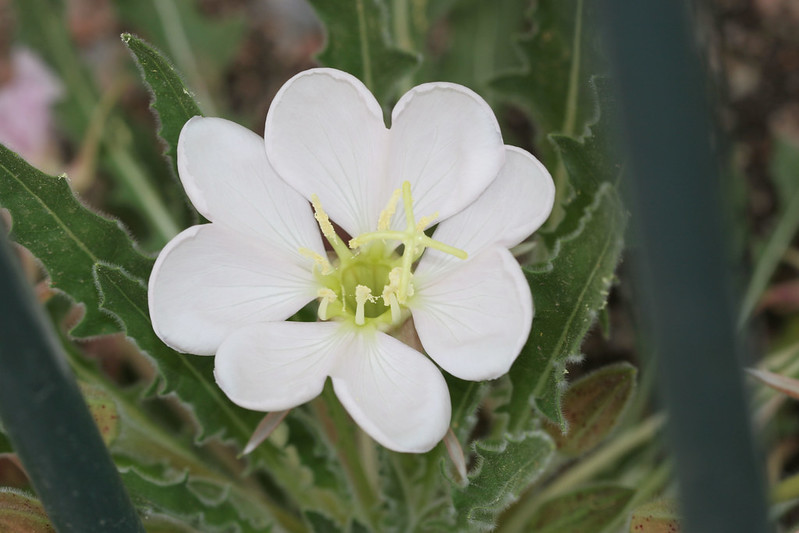
Photo Credit: Andrey Zharkikh / Flickr / CC BY 2.0
Tufted evening primrose is known for its intoxicatingly fragrant flowers that open in the coolness of the evening and glow white until the sun rises. The process itself is a sight to behold. The 3 to four-inch white flowers open at dusk, shine brilliantly through the darkness, and fade to pink as they fold up when temperatures begin climbing in the morning. Hairy, narrow gray-green leaves also fold up when hot to keep from losing moisture.
Even though the tufted evening primrose is native to the Sonoran Desert and needs very little water, with moderate irrigation, you’ll see a bounty of blooms all summer long. You’ll also see night-flying hawkmoths visit the flowers at night. They love the plant and are one of the few animals who can reach nectar that collects at the base of the tubular flowers.
Life Cycle: Herbaceous perennial
Mature Height: 12 inches
Mature Width: 2 feet
Sunlight Needs: Full sun
Soil Preferences: Dry, clay soils
Water Requirements: Low needs, but more water improves flowering
Disease or Insect Problems: No serious problems
Firecracker Penstemon (Penstemon eatonii)

Photo Credit: Matt Lavin / Wikimedia Commons / CC BY-SA 2.0
The firecracker penstemon is an excellent addition to any Phoenix yard if you want winter color in February and March. Scarlet-red blooms open along tall bloom spikes in early to mid-spring, lasting four to six weeks.
These flowering plants do best in sandy soils that drain well and love it if they get sun from the north, south, or east. Avoid fertilizing firecracker penstemon plants. They are known to “bloom themselves to death” when given adequate nutrients.
Growth Habit: Herbaceous perennial
Mature Height: 2 to 3 feet
Mature Width: 15 inches
Sunlight Needs: Full sun
Soil Preferences: Well-drained
Water Requirements: Occasional watering in summer
Disease or Insect Problems: Susceptible to root rot
Desert Marigold (Baileya multiradiata)

Photo Credit: Kenraiz / Wikimedia Commons / CC BY-SA 4.0
The desert marigold adds color to your landscape from late winter to mid-spring with its impressive mounds of daisy-like bright yellow flowers. Plants may bloom the rest of the year intermittently with supplemental water. It grows much shorter than other plants on our list, making it a great accent plant or addition to your native wildflower garden.
These attractive plants easily reseed themselves, helping to fill in bare spots over time. When desert marigolds are in full bloom, snip some stalks for a cut flower arrangement and bring the bright color inside.
Growth Habit: Herbaceous perennial
Mature Height: 20 inches
Mature Width: 4 to 12 inches
Sunlight Needs: Full sun
Soil Preferences: Well-drained
Water Requirements: Needs little water if winter rains are sufficient
Disease or Insect Problems: Root rot, crown rot
White Desert Plumbago (Plumbago scandens)
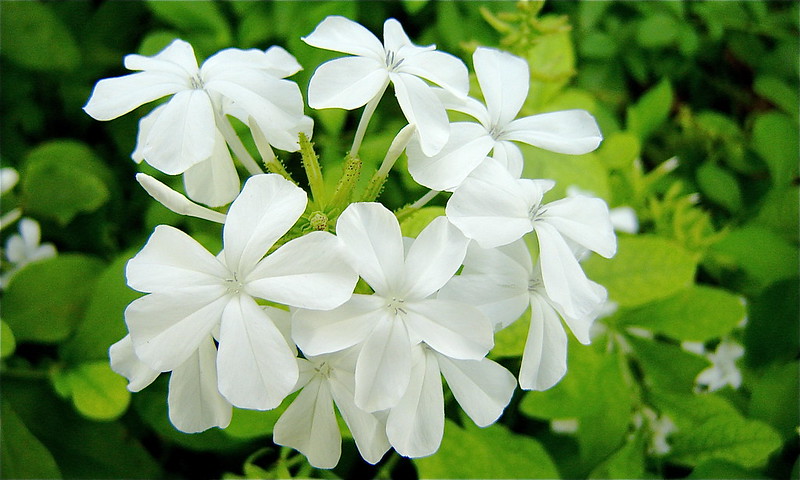
Photo Credit: Adrianna Moya Photography / Flickr / CC BY 2.0
The sprawling white desert plumbago is gaining popularity for its startlingly bright white flowers that pop against dramatically deep green evergreen foliage. These plants prefer part sun, which is surprising for a Sonoran Desert native, but their propensity for slight shade make them great for growing under trees or taller shrubs.
A low-maintenance, easy-going plant, the white desert plumbago tolerates various soils, and a little supplemental water promotes a showy flower display and lush foliar growth. You can also plant it along the edge of your yard if you’re looking for an innovative, informal living fence or hedge.
Growth Habit: Evergreen shrub
Mature Height: 3 to 4 feet
Mature Width: 3 to 4 feet
Sunlight Needs: Full to part sun
Soil Preferences: Tolerates most soils
Water Requirements: Low to moderate
Disease or Insect Problems: White fly
Arizona Poppy (Kallstroemia grandiflora)
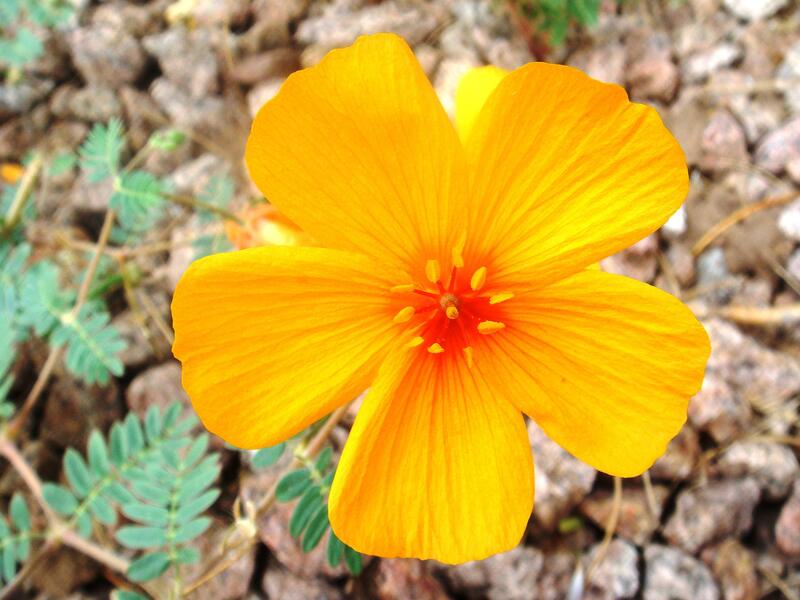
Photo Credit: Miwasatoshi / Wikimedia Commons / CC BY-SA 4.0
The Arizona poppy is the only annual plant on this list, but it self-seeds, so new plants may germinate year after year if conditions are right. While not an actual poppy, it gets its name from its yellow-orange flowers that look like California poppies. It blooms prolifically from July to October in Phoenix.
Plant Arizona poppies as a groundcover in open spaces with room to spread and grow. An individual plant can easily reach three to five feet across, putting on a brilliant display in full bloom. The spectacular flowers attract birds; the seeds are an essential food source for doves and quail.
Growth Habit: Summer annual
Mature Height: 1 ½ to 3 feet
Mature Width: 3 to 5 feet
Sunlight Needs: Full sun
Soil Preferences: Prefers light, well-drained, but tolerates all soils
Water Requirements: Supplemental light watering during dry periods
Disease or Insect Problems: No serious problems
Desert Ironwood (Olneya tesota)

Photo Credit: Thayne Tuason / Wikimedia Commons / CC BY 4.0
If you want to add shade to your yard and love the classic, twisted “desert tree” look, desert ironwood is a great choice! This slow-growing tree tolerates many different soils and can easily grow over 30 feet tall when given enough water. It is one of the few desert trees that doesn’t shed its leaves, providing light shade year-round.
Desert ironwoods bloom profusely in spring, displaying pinkish-purple flowers that look similar to the flowers on sweet peas. The extremely dense desert ironwood is culturally and ecologically important, serving as a staple in the Mexican carving trade.
Growth Habit: Flowering tree
Mature Height: 30 feet, but varies with irrigation
Mature Width: 25 feet
Sunlight Needs: Full sun
Soil Preferences: Tolerates a variety of soils
Water Requirements: Periodic watering in the summer to help with vigor
Disease or Insect Problems: No serious problems
Desert Willow (Chilopsis linearis)
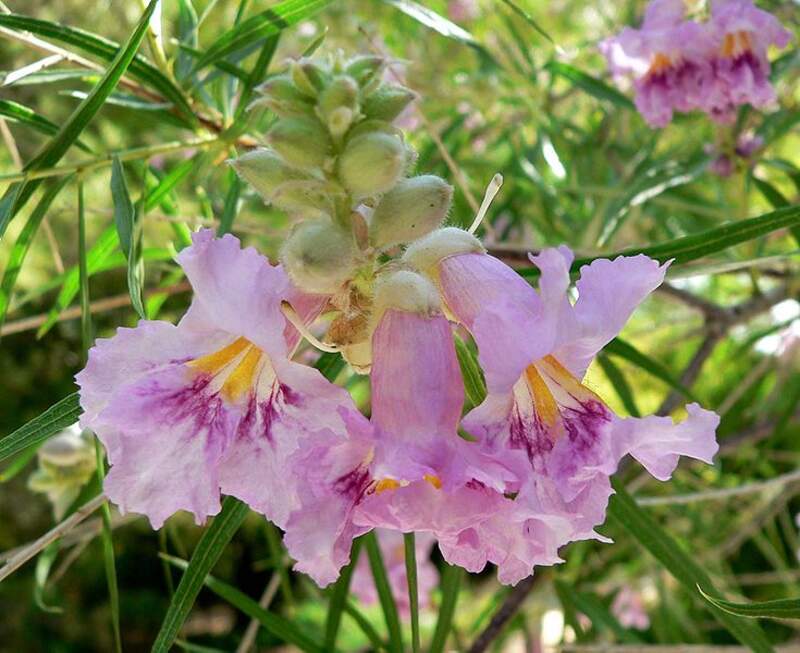
Photo Credit: Stan Shebs / Wikimedia Commons / CC BY-SA 3.0
Native to the Southwestern United States, the desert willow is a great small tree for arid climates. This hardy tree handles temperatures down to 10°F and tolerates many soil types. In the summer (April through September or October), it is filled with trumpet-shaped pale pink, white, or purple flowers.
It does form a weeping growth habit but isn’t related to the weeping willow common across other parts of the country. The desert willow is deciduous, which means it sheds leaves during the cooler winter months and isn’t as attractive as when in bloom. If you can handle the shocking transformation between seasons, having it in your garden when flowering is worthwhile.
Growth Habit: Deciduous tree
Mature Height: 15 to 35 feet
Mature Width: 25 feet
Sunlight Needs: Full sun
Soil Preferences: Tolerates a variety of soil types
Water Requirements: Some watering during summer to support foliage
Disease or Insect Problems: Root rot
Deer Grass (Muhlenbergia rigens)

Photo Credit: Stan Shebs / Wikimedia Commons / CC BY-SA 3.0
Deer grass is a beautiful, easy-to-grow native bunchgrass with light silver-green to purple blades that pour out like a waterfall from the plant’s center. It prefers sandy or rocky soils but will grow anywhere that’s well-drained and receives at least eight hours of sun.
These grasses make great landscape accent pieces. Long, arching flower panicles develop in spring and change from a creamy white to a straw color by late summer.
Growth Habit: Ornamental grass
Mature Height: 3 to 5 feet
Mature Width: 3 to 5 feet
Sunlight Needs: Full sun
Soil Preferences: Well-drained
Water Requirements: Weekly or once every two weeks during summer
Disease or Insect Problems: No serious problems
Bull Grass (Muhlenbergia emersleyi)

Photo Credit: Patrick Alexander / Flickr / CC0 1.0
Bull grass is a classic-looking, coarse-textured desert grass that grows upwards of 3 feet tall and 2 feet wide. It prefers dry, well-drained soil, often growing on rocky ledges, slopes, and forest edges.
From June to November, the long blue-green leaves send up massive clumps of purplish flower spikes, which dry to a tannish color during winter. Bull grass’ fast-growing root system is fantastic for erosion control.
Growth Habit: Ornamental grass
Mature Height: 3 feet
Mature Width: 3 feet
Sunlight Needs: Full sun or partial shade
Soil Preferences: Well-drained
Water Requirements: Occasional during severe dry periods
Disease or Insect Problems: No serious problems
Saguaro (Carnegiea gigantea)
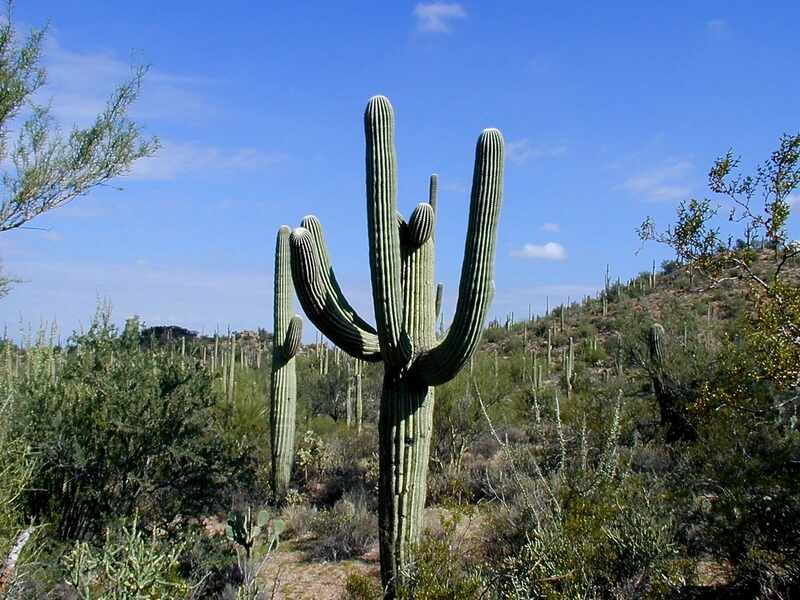
Photo Credit: Pxhere
Very few plants say Arizona desert like the saguaro cactus! These plants grow very slowly when started from seed and easily live to be over 200 years old. If you’re looking for something that many generations will enjoy to come, the saguaro is a top choice.
Once established, saguaros make a stunning focal point in Phoenix home landscapes as the largest cactus type in the United States. The mammoth, tree-like plant develops arm-shaped branches that bend upward to give it its iconic shape. Large specimens can have more than two dozen “arms.”
Growth Habit: Cactus
Mature Height: 25 to 50 feet
Mature Width: Up to 25 feet
Sunlight Needs: Full sun
Soil Preferences: Well-drained
Water Requirements: None after establishment
Disease or Insect Problems: Bacterial necrosis
Hedgehog Cactus (Echinocereus engelmannii)
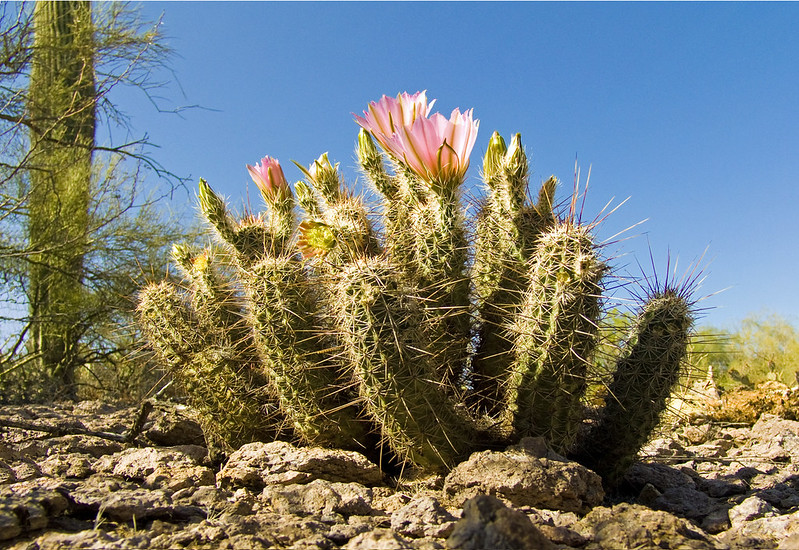
Photo Credit: Brent Myers / Flickr / CC 2.0
Much smaller than the saguaro, the hedgehog cactus is a low-growing succulent adorned with short, spiny stems resembling hedgehogs. Plants grow in clusters of up to 60 stems in sandy, rocky soils on exposed slopes and desert prairies. In March and April, all varieties of the cylindrical cacti display magnificent pink or purple blossoms. The flowers last about five days, opening in the morning and closing at night.
After flowing, the hedgehog cactus produces red-orange fruit whose fleshy white pulp tastes like strawberry. At first, sharp spines inhibit fruit picking, but as fruits mature and ripen, the spines fall off.
Growth Habit: Cactus
Mature Height: 12 inches
Mature Width: 3 feet
Sunlight Needs: Full to part sun
Soil Preferences: Well-drained
Water Requirements: None after establishment
Disease or Insect Problems: Mealybugs, scale insects
Sugar Sumac (Rhus ovata)

Photo Credit: Michael J. Plagens / Wikimedia Commons / CC BY-SA 3.0
Native to the foothills and mountains of the Southwest, sugar sumac (also called sugar bush) is commonly found growing in dry canyons and on exposed slopes. Prized for its deep green leathery evergreen leaves, this shrub is often used in parks and along freeways as a filler plant. Hence, it is an excellent choice if you have ample space in your yard you want to be filled with greenery.
Plants are resilient and easy to grow, reaching 10 feet tall in as little as three years. When sugar sumac is grown in residential gardens, it needs water only once a month to encourage small white flowers with red sepals to adorn the reddish twigs.
Growth Habit: Evergreen shrub
Mature Height: 6 to 15 feet
Mature Width: 8 to 10 feet
Sunlight Needs: Full sun
Soil Preferences: Well-drained
Water Requirements: No irrigation needed in high elevations. In lower elevations, water infrequently but deeply.
Disease or Insect Problems: No serious problems in dry climates
How to Choose Native Plants
All of these native plants will do well in Phoenix with its hot temperatures and low rainfall, but you need to consider a couple of things.
What kind of soil are you working with?
People automatically think that since Phoenix is in the desert, it has sandy soil. The truth, though, is that you can find some sandy soils in the Valley, and you can also find heavy clay soils known as caliche.
These caliche soils are almost cemented with calcium carbonate and do not drain well. If you have this type in your yard, you’ll need to avoid plants that need well-draining soil or are prone to root rot.
Is your yard in full sun, or are you planting in partial or full-shade spots?
These native plants mostly prefer full sun and have excellent heat tolerance. If you have a spot shaded by your house, fence, or other plants at times during the day, white desert plumbago, bull grass, and hedgehog cactus can tolerate partial shade.
What size space are you working with?
When looking at plants, always consider their mature size, not their size when you buy them. You don’t want to move a plant that’s too big for the space after a few years.
Where to Purchase Native Plants in Phoenix
Buying native plants is a great way to encourage sustainability, as they have naturally adapted to your local climate and growing conditions. When purchasing plants, though, it’s even better to try and find natives that were propagated and raised in your region. A plant may be native to the Sonoran desert, but if the seedling was grown elsewhere, it might not tolerate the hot summers.
If you’re looking for local plants, check out the following retailers, or contact the Phoenix chapter of the Arizona Native Plant Society or Maricopa County Cooperative Extension for more information.
Desert Foothills Gardens Nursery Inc.
Whitfill Nursery
If you dream of a yard filled with native plants, but need a little help, reach out to our Phoenix lawn care pros! They can make your landscaping dreams come true and thrive in this challenging Valley of the Sun climate.
Main Image Credit: Pxfuel